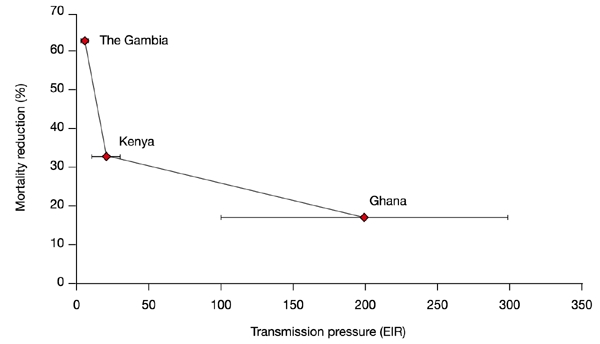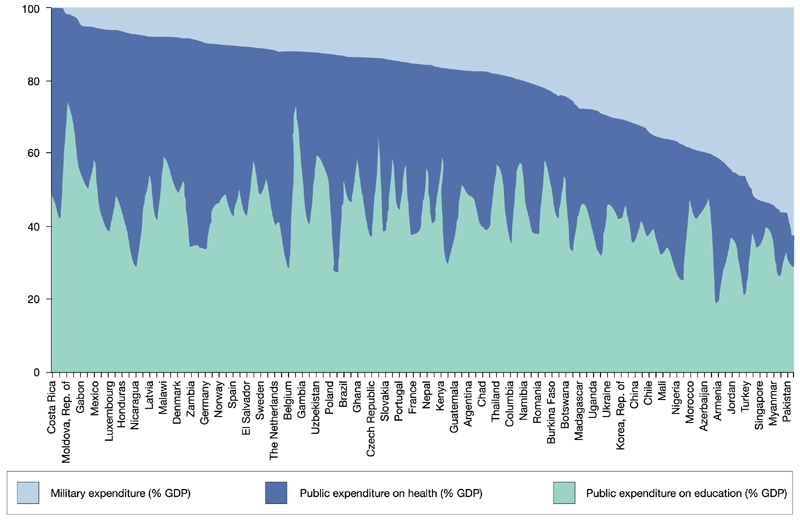Abstract
Can we change this reality?
Health, science and technology are increasingly being recognized as prerequisites for economic and social development, and not merely as their consequences (Sachs, 2001, 2002). However, despite recent scientific and technological advances, infectious diseases continue to affect poor and marginalized populations disproportionately (Gwatkin & Guillot, 2000). From a public-health point of view, three key factors contribute to this burden: failure to use existing tools effectively; inadequate, failing or non-existent tools; and insufficient knowledge of the disease (World Health Organization (WHO), 1996; Trouiller et al., 2002).
It has been estimated that less than 10% of global spending on health research is devoted to diseases or conditions that account for 90% of the global disease burden (Global Forum for Health Research, 2002). This 'market failure', often reinforced by the simplistic view that current technical tools are sufficient for effective disease control, has given rise to a global 'drug gap' (Reich, 2000), in which the private sector invests almost exclusively in drugs for the developed world that will be marketable and profitable. As a result, there are now 'neglected diseases', such as HIV/AIDS, tuberculosis (TB) and malaria, that are starting to be tackled by recent public–private partnerships, and the 'most-neglected diseases', such as sleeping sickness and Chagas disease, that are virtually ignored in terms of drug development and continue to plague the developing world (Médecins Sans Frontières, 2001; Yamey, 2002). But this reality could be changed. For example, better use could be made of existing interventions, as has been shown recently for public health in general in Tanzania
The frequently mentioned 'unfinished agenda' for the perennial fight against infectious and parasitic diseases might, in fact, never come to an end
(The Economist, 2002) and more specifically for Chagas' disease (De Andrade et al., 1996; Morel, 1999) and malaria (Schellenberg et al., 2001). In addition, new or improved tools against tropical diseases have been developed, such as combination therapy for malaria (Nosten & Brasseur, 2002) and miltefosine for visceral leishmaniasis (Jha et al., 1999; Sundar et al., 2002).
However, the problem remains formidable. The frequently mentioned 'unfinished agenda' for the perennial fight against infectious and parasitic diseases might, in fact, never come to an end. On the one hand, emerging and re-emerging diseases, such as HIV/AIDS and TB, continuously pose new threats; on the other hand, disease control interventions might fail—for example, because of increased resistance of pathogens to drugs—or vary in efficacy according to epidemiological settings or vector biology, as illustrated in Fig. 1.
Figure 1.

Impact of impregnated bednets on child mortality in Africa. Trials conducted in areas of seasonal malaria transmission have shown that bednets can be highly protective in areas of low transmission pressure, such as the area studied in The Gambia (entomological inoculation rate (EIR) of 1–10 infective bites per person per year; Alonso et al., 1991). However, protection decreases sharply in areas of higher transmission pressure, as shown by trials in Kenya (EIR of 10–30; Nevill et al., 1996) or Ghana (EIR of 100–300; Binka et al., 1996; see also http://www.netmarkafrica.org/keyissues/itm_brief.html).
Sustainable solutions will, among other things, require: recognition that research is critical in the fight against disease and that prioritization is essential for health research (Sachs, 2001; Remme et al., 2002); full exploration of the potential of modern science and technology (Advisory Committee on Health Research, 2002; Kafatos, 2002); new arrangements and conditions so that the best use is made of research for policy-making (Sauerborn et al., 1999); and serious engagement of disease-endemic countries in a new, international pharmaceutical policy for all neglected diseases (Trouiller et al., 2002).
The obstacles that prevent progress being made against neglected infectious diseases are varied and differ in nature. Market and public-health failures are clear contributors, but there is also the dilemma between continuing to carry out disease control with the tools available at present, and investing in health research for the benefit of future generations (Curtis, 2000; Hoffman, 2000; James et al., 2001)—a variation of the classical tension between use and understanding. The different cultures and visions of policy makers and decision makers, disease control experts and health researchers (Morel, 2000) are a hindrance, in particular the belief that 'the job can be
...military-orientated governments are prone to finance war and armed conflicts at the expense of the health systems and services of their populations
done' using existing tools, for 'all one needs is good management'. Although this reasoning can be valid on those rare occasions when a powerful, cost-effective intervention exists, history has shown that having research as an integral component of public health campaigns is the key to success (Henderson, 1998a; Molyneux & Morel, 1998). Another obstacle is the belief that investments in basic research alone will automatically lead to the development of new tools and their seamless adoption and use by the health systems of poor countries. This vision correctly emphasizes the existence of knowledge gaps, but disregards how difficult it is to translate health research into policy and practice and how complex the relationships are between basic science and technological innovation (Kealey, 1996; Stokes, 1997). Finally, the low priority given to public health and health research by most disease-endemic countries themselves exacerbates the situation.
A long-term, multi-pronged approach is needed if we are to move beyond these short-sighted dilemmas and the resulting virtual boundaries that undermine synergy, team-building and collaboration between all health stakeholders. Only in this way can we start to work seriously towards achieving the Millennium Development Goals (United Nations, 2002) of combating child mortality, HIV/AIDS and neglected diseases. In the context of this article, I would like to single out one challenge, one threat and one responsibility among all those facing humankind, which, if addressed, will significantly help towards achieving these goals.
The challenge I consider fundamental is how to rescue the role, the need and the importance of strategic research—research that is both basic and applied and thus falls into Pasteur's Quadrant (Stokes, 1997). The information that modern science and technology can generate, particularly in genomics and associated fields, has to be transformed into breakthroughs for public health (Morel et al., 2002). This 'genomics knowledge' will be the basis for the development of the new health interventions that are so desperately needed for the control of infectious disease. However, if this challenge is left exclusively in the hands of market forces, or addressed by laissez-faire scientific and technological policies, genomics will increase the divide between the rich and the poor, instead of bridging it (Singer & Daar, 2001; Advisory Committee on Health Research, 2002; Daar et al., 2002).
The threats of infectious diseases are so numerous that it is impossible to single out a specific one. Instead of attempting to select 'the' killer disease, I nominate as the most dangerous threat the deeply rooted perception that the war against infectious diseases has been won. This perception not only ignores the extraordinary capacity of our biological enemies to evolve continuously and to spread death and terror, but also does not take into consideration the possibility of the voluntary spread of infections by bioterrorism and biological warfare (Henderson, 1998b, 1999, 2000; Feldmann et al., 2002). Although an 'Ebola with wings' is still a hypothesis rather than a reality, one should not forget that influenza pandemics are permanently on the horizon and that bioterrorism has already killed innocent people. The postponement of the destruction of the last stocks of smallpox virus, and the resulting necessity of spending millions of dollars on mass vaccination campaigns against a disease that was officially certified as having been eradicated on 9 December 1979 (Fenner et al., 1988), is a sad outcome (Cassels, 2002) and illustrates how real, powerful and far-reaching is the threat of infectious diseases.
Who should bear the responsibility of tackling neglected diseases? In the international health arena it is common to divide nations into 'donor' and 'recipient' countries and to refer to them collectively as 'the North' and 'the South'—the result is a strange atlas in which, for example, Australia is in the North and India is in the South. This heritage from the colonial era stimulates alienation and favours the status quo, as its subliminal message implies that a major responsibility for the solution of the problems of the 'the South' relies on help or charity from 'the North'. As a matter of fact, it is true that the health systems of some of the more highly developed countries rely continuously on foreign aid to keep alive their basic infrastructure and the delivery of essential services. Indeed, the real picture is much more complex than a simple North–South divide. Figure 2 reflects the priorities in public spending in education, health and military expenditures for the 108 countries for which this information was available (United Nations Development Programme, 2002). As the proportion of military expenditure increases from 0% of GDP (for example, in Iceland and Costa Rica) to 10% or more (Eritrea with 22.9%, Angola with 21.2%, and others not included due to lack of health and education data), the share of the health component (the darker area in the figure) shrinks drastically when compared with education. In other words, military-orientated governments are prone to finance war and armed conflicts at the expense of the health systems and services of their populations.
Disease-endemic countries have to take centre stage in the fight against war and ill health to foster their own development
Figure 2.

Distributions of public expenditure on education and health and of military expenditure for 108 countries, ranked by increasing proportion of military expenditure. Data from Human Development Report 2002 (United Nations Development Programme, 2002).
A complex interplay between ill health, economic and political factors links infection rates and the risk of armed conflict, and infectious diseases are thought to influence the onset or 'pathogenesis' of wars in the developing world (Broder et al., 2002). No charity-driven health aid alone can fundamentally alter this picture. Disease-endemic countries have to take centre stage in the fight against war and ill health to foster their own development. Truly democratic regimens that empower people have to be built; they cannot be imported or donated (United Nations Development Programme, 2002). In turn, developed economies have to move beyond traditional development aid or the support of scattered health partnerships; these mechanisms may appease consciences, but they are no substitute for fair commercial trade and sound economic policies. The task of coping with the immense toll that infectious and parasitic diseases inflict on the developing world has, therefore, to be seen as our common responsibility and a challenge that must not be neglected.

References
- Advisory Committee on Health Research (2002) Genomics and World Health (http://www3.who.int/whosis/genomics/genomics_report.cfm). WHO, Geneva, Switzerland. [Google Scholar]
- Alonso P.L. et al. (1991) The effect of insecticide-treated bed nets on mortality of Gambian children. Lancet, 337, 1499–1502. [DOI] [PubMed] [Google Scholar]
- Binka F.N. et al. (1996) Impact of permethrin impregnated bednets on child mortality in Kassena-Nankana district, Ghana: a randomized controlled trial. Trop. Med. Int. Health, 1, 147–154. [DOI] [PubMed] [Google Scholar]
- Broder S., Hoffman S.L. & Hotez P.J. (2002) Cures for the Third World's problems. EMBO Rep., 3, 806–812. [DOI] [PMC free article] [PubMed] [Google Scholar]
- Cassels A. (2002) Bioterrorism becoming too dominant on public health agenda? Can. Med. Assoc. J., 167, 1281. [PMC free article] [PubMed] [Google Scholar]
- Curtis C.F. (2000) The case for deemphasizing genomics in malaria control. Science, 290, 1508. [DOI] [PubMed] [Google Scholar]
- Daar A.S. et al. (2002) Top ten biotechnologies for improving health in developing countries. Nature Genet., 32, 229–232. [DOI] [PubMed] [Google Scholar]
- De Andrade A.L. et al. (1996) Randomised trial of efficacy of benznidazole in treatment of early Trypanosoma cruzi infection. Lancet, 348, 1407–1413. [DOI] [PubMed] [Google Scholar]
- Feldmann H. et al. (2002) Emerging and re-emerging infectious diseases. Med. Microbiol. Immunol., 191, 63–74. [DOI] [PubMed] [Google Scholar]
- Fenner F., Henderson D.A., Arita I., Jezek Z. & Ladnyi I.D. (1988) Smallpox and its eradication. WHO, Geneva, Switzerland. [Google Scholar]
- Gwatkin D.R. & Guillot M. (2000) The Burden of Disease Among the Global Poor. The World Bank, Washington, USA. [DOI] [PubMed] [Google Scholar]
- Global Forum for Health Research (2002) The 10/90 Report on Health Research 2001–2002. Global Forum for Health Research, Geneva, Switzerland.
- Henderson D.A. (1998a) Eradication: lessons from the past. Bull. World Health Org., 76 (Suppl. 2), 17–21. [PMC free article] [PubMed] [Google Scholar]
- Henderson D.A. (1998b) Bioterrorism as a public health threat. Emerg. Infect. Dis., 4, 488–492. [DOI] [PMC free article] [PubMed] [Google Scholar]
- Henderson D.A. (1999) The looming threat of bioterrorism. Science, 283, 1279–1282. [DOI] [PubMed] [Google Scholar]
- Henderson D.A. (2000) Bioterrorism. Int. J. Clin. Pract. Suppl., December, 32–36. [PubMed] [Google Scholar]
- Hoffman S.L. (2000) Research (genomics) is crucial to attacking malaria. Science, 290, 1509. [DOI] [PubMed] [Google Scholar]
- James A.A., Morel C.M., Hoffman S.L. & Curtis C.F. (2001) Present and future control of malaria. Science, 291, 435–436. [PubMed] [Google Scholar]
- Jha T.K. et al. (1999) Miltefosine, an oral agent, for the treatment of Indian visceral leishmaniasis. N. Engl. J. Med., 341, 1795–1800. [DOI] [PubMed] [Google Scholar]
- Kafatos F.C. (2002) A revolutionary landscape: the restructuring of biology and its convergence with medicine. J. Mol. Biol., 319, 861–867. [DOI] [PubMed] [Google Scholar]
- Kealey T. (1996) The Economic Laws of Scientific Research. St Martin's Press, Inc., New York, USA. [Google Scholar]
- Médecins Sans Frontières Access to Essential Medicines Campaign and the Drugs for Neglected Diseases Working Group (2001) Fatal Imbalance: The Crisis in Research and Development for Drugs for Neglected Diseases. MSF Access to Essential Medicines Campaign, Brussels, Belgium. [Google Scholar]
- Molyneux D.H. & Morel C. (1998) Onchocerciasis and Chagas' disease control: the evolution of control via applied research through changing development scenarios. Br. Med. Bull., 54, 327–339. [DOI] [PubMed] [Google Scholar]
- Morel C.M. (1999) Chagas disease, from discovery to control — and beyond: history, myths and lessons to take home. Mem. Inst. Oswaldo Cruz, 94, 3–16. [DOI] [PubMed] [Google Scholar]
- Morel C.M. (2000) Health research and disease control: two different cultures, one common goal (Editorial). Action Against Infect., 3, 1–2. [Google Scholar]
- Morel C.M., Toure Y.T., Dobrokhotov B. & Oduola A.M. (2002) The mosquito genome—a breakthrough for public health. Science, 298, 79. [DOI] [PubMed] [Google Scholar]
- Nevill C.G. et al. (1996) Insecticide-treated bednets reduce mortality and severe morbidity from malaria among children on the Kenyan coast. Trop. Med. Int. Health, 1, 139–146. [DOI] [PubMed] [Google Scholar]
- Nosten F. & Brasseur P. (2002) Combination therapy for malaria: the way forward? Drugs, 62, 1315–1329. [DOI] [PubMed] [Google Scholar]
- Reich M.R. (2000) The global drug gap. Science, 287, 1979–1981. [DOI] [PubMed] [Google Scholar]
- Remme J.H.F. et al. (2002) Strategic emphases for tropical diseases research: a TDR perspective. Trends Parasitol., 18, 421–426. [DOI] [PubMed] [Google Scholar]
- Sachs J.D. (2001) Macroeconomics and Health: Investing in Health for Economic Development. Report of the Commision on Macroeconomics and Health. WHO, Geneva, Switzerland. [Google Scholar]
- Sachs J. (2002) The essential ingredient. New Sci., 175, 52–55. [Google Scholar]
- Sauerborn R., Nitayarumphong S. & Gerhardus A. (1999) Strategies to enhance the use of health systems research for health sector reform. Trop. Med. Int. Health, 4, 827–835. [DOI] [PubMed] [Google Scholar]
- Schellenberg D. et al. (2001) Intermittent treatment for malaria and anaemia control at time of routine vaccinations in Tanzanian infants: a randomised, placebo-controlled trial. Lancet, 357, 1471–1477. [DOI] [PubMed] [Google Scholar]
- Singer P.A. & Daar A.S. (2001) Harnessing genomics and biotechnology to improve global health equity. Science, 294, 87–89. [DOI] [PubMed] [Google Scholar]
- Stokes D.E. (1997) Pasteur's Quadrant: Basic Science and Technological Innovation. The Brookings Institution, Washington DC, USA. [Google Scholar]
- Sundar S. et al. (2002) Oral miltefosine for Indian visceral leishmaniasis. N. Engl. J. Med., 347, 1739–1746. [DOI] [PubMed] [Google Scholar]
- The Economist (2002) For 80 cents more. 364, 20–22.
- Trouiller P. et al. (2002) Drug development for neglected diseases: a deficient market and a public-health policy failure. Lancet, 359, 2188–2194. [DOI] [PubMed] [Google Scholar]
- United Nations (2002) UN Millennium Development Goals (MDG). http://www.un.org/millenniumgoals/ [Google Scholar]
- United Nations Development Programme (2002) Human Development Report 2002. Deepening Democracy in a Fragmented World. United Nations, New York, USA.
- WHO (1996) Investing in Health Research and Development. Report of the Ad Hoc Committee on Health Research Relating to Future Intervention Options. WHO (Document TDR/Gen/96.1), Geneva, Switzerland.
- Yamey G. (2002) The world's most neglected diseases. BMJ, 325, 176–177. [DOI] [PMC free article] [PubMed] [Google Scholar]


